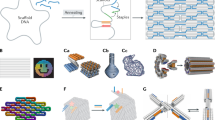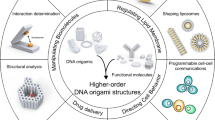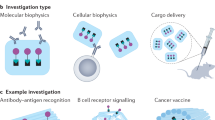Abstract
Biological systems often rely on topological transformation to reconfigure connectivity between nodes to guide the flux of molecular information. Here we develop a topology-programmed DNA origami system that encodes signal propagation at the nanoscale, analogous to topologically efficient information processing in cellular systems. We present a systematic molecular implementation of topological operations involving ‘glue–cut’ processes that can prompt global conformational change of DNA origami structures, with demonstrated major topological properties including genus, number of boundary components and orientability. By spatially arranging reactive DNA hairpins, we demonstrate signal propagation across transmission paths of varying lengths and orientations, and curvatures on the curved surfaces of three-dimensional origamis. These DNA origamis can also form dynamic scaffolds for regulating the spatial and temporal signal propagations whereby topological transformations spontaneously alter the location of nodes and boundary of signal propagation network. We anticipate that our strategy for topological operations will provide a general route to manufacture dynamic DNA origami nanostructures capable of performing global structural transformations under programmable control.

This is a preview of subscription content, access via your institution
Access options
Access Nature and 54 other Nature Portfolio journals
Get Nature+, our best-value online-access subscription
$32.99 / 30 days
cancel any time
Subscribe to this journal
Receive 12 print issues and online access
$259.00 per year
only $21.58 per issue
Buy this article
- Purchase on SpringerLink
- Instant access to full article PDF
Prices may be subject to local taxes which are calculated during checkout





Similar content being viewed by others
Data availability
The data and experimental protocols for this work are available within Supplementary Information and from the corresponding author on request. Supplementary Information is available in the online version of the paper. The design files and oxDNA simulation results are available at https://nanobase.org/structure/184. Source data are provided with this paper.
References
Stadhouders, R., Filion, G. J. & Graf, T. Transcription factors and 3D genome conformation in cell-fate decisions. Nature 569, 345–354 (2019).
Chen, H., Li, C., Zhou, Z. & Liang, H. Fast-evolving human-specific neural enhancers are associated with aging-related diseases. Cell syst. 6, 604–611 (2018).
Bullmore, E. & Sporns, O. The economy of brain network organization. Nat. Rev. Neurosci. 13, 336–349 (2012).
Bullmore, E. & Sporns, O. Complex brain networks: graph theoretical analysis of structural and functional systems. Nat. Rev. Neurosci. 10, 186–198 (2009).
Dixon, J. R., Gorkin, D. U. & Ren, B. Chromatin domains: the unit of chromosome organization. Mol. Cell 65, 668–680 (2016).
Sexton, T. & Cavalli, G. The role of chromosome domains in shaping the functional genome. Cell 160, 1049–1059 (2015).
Liu, P., Williams, J. R. & Cha, J. J. Topological nanomaterials. Nat. Rev. Mater. 4, 479–496 (2019).
Li, L. L. et al. Intracellular construction of topology-controlled polypeptide nanostructures with diverse biological functions. Nat. Commun. 8, 1276 (2017).
Forgan, R. S., Sauvage, J. P. & Stoddart, J. F. Chemical topology: complex molecular knots, links, and entanglements. Chem. Rev. 111, 5434–5464 (2011).
Chichak, K. S. et al. Molecular borromean rings. Science 304, 1308–1312 (2004).
Schill, G. Catenanes, Rotaxanes and Knots (Academic Press, 1971).
Sauvage, J. P. & Christiane, D. B. Molecular Catenanes, Rotaxanes and Knots: A Journey through the World of Molecular Topology (Wiley-VCH, 1999).
Seeman, N. C. DNA in a material world. Nature 421, 427–431 (2003).
Pinheiro, A. V., Han, D., Shih, W. M. & Yan, H. Challenges and opportunities for structural DNA nanotechnology. Nat. Nanotechnol. 6, 763–772 (2011).
Chen, Y. J., Groves, B., Muscat, R. A. & Seelig, G. DNA nanotechnology from the test tube to the cell. Nat. Nanotech. 10, 748–760 (2015).
Condon, A. Designed DNA molecules: principles and applications of molecular nanotechnology. Nat. Rev. Genet. 7, 565–575 (2006).
Dey, S. et al. DNA origami. Nat. Rev. Methods Primers 1, 13 (2021).
Liu, D., Chen, G., Akhter, U., Cronin, T. M. & Weizmann, Y. Creating complex molecular topologies by configuring DNA four-way junctions. Nat. Chem. 8, 907–914 (2016).
Kočar, V. et al. Design principles for rapid folding of knotted DNA nanostructures. Nat. Commun. 7, 10803 (2016).
Bucka, A. & Stasiak, A. Construction and electrophoretic migration of single-stranded DNA knots and catenanes. Nucleic Acids Res. 30, e24 (2002).
Rothemund, P. Folding DNA to create nanoscale shapes and patterns. Nature 440, 297–302 (2006).
Ramezani, H. & Dietz, H. Building machines with DNA molecules. Nat. Rev. Genet. 21, 5–26 (2020).
Qi, X. et al. Programming molecular topologies from single-stranded nucleic acids. Nat. Commun. 9, 4579 (2018).
Mokhtar, R. et al. DNA Origami Transformers (DNA‐and RNA‐Based Computing Systems, 2021).
Siavashpouri, M., Wachauf, C. H., Zakhary, M. J., Praetorius, F. Dietz, H. & Dogic, Z. Molecular engineering of chiral colloidal liquid crystals using DNA origami. Nat. Mater. 16, 849–856 (2017).
Yin, P. et al. Programming DNA tube circumferences. Science 321, 824–826 (2008).
Song, J. et al. Reconfiguration of DNA molecular arrays driven by information relay. Science 357, eaan3377 (2017).
Goodman, R. P. et al. Reconfigurable, braced, three-dimensional DNA nanostructures. Nat. Nanotech. 3, 93–96 (2008).
Zhang, Z., Yang, Y., Pincet, F., Llaguno, M. C. & Lin, C. Placing and shaping liposomes with reconfigurable DNA nanocages. Nat. Chem. 9, 653–659 (2017).
Han, D., Pal, S., Liu, Y. & Yan, H. Folding and cutting DNA into reconfigurable topological nanostructures. Nat. Nanotech. 5, 712–717 (2010).
Gu, H., Chao, J., Xiao, S. J. & Seeman, N. C. A proximity-based programmable DNA nanoscale assembly line. Nature 465, 202–205 (2010).
Li, J. et al. Exploring the speed limit of toehold exchange with a cartwheeling DNA acrobat. Nat. Nanotechnol. 13, 723–729 (2018).
Yin, P., Yan, H., Daniell, X. G., Turberfield, A. J. & Reif, J. H. A unidirectional DNA walker that moves autonomously along a track. Angew. Chem. Int. Ed. 116, 5014–5019 (2004).
Stupka, I. et al. Chemically induced protein cage assembly with programmable opening and cargo release. Sci. Adv. 8, eabj9424 (2022).
Liu, M. et al. A DNA tweezer-actuated enzyme nanoreactor. Nat. Commun. 4, 1–5 (2013).
Douglas, S. M., Bachelet, I. & Church, G. M. A logic-gated nanorobot for targeted transport of molecular payloads. Science 335, 831–834 (2012).
Thubagere, A. J. et al. A cargo-sorting DNA robot. Science 357, eaan6558 (2017).
Wickham, S. F. J. et al. A DNA-based molecular motor that can navigate a network of tracks. Nat. Nanotechnol. 7, 169–173 (2012).
Lund, K. et al. Molecular robots guided by prescriptive landscapes. Nature 465, 206–210 (2010).
Yan, H., Zhang, X., Shen, Z. & Seeman, N. C. A robust DNA mechanical device controlled by hybridization topology. Nature 415, 62–65 (2002).
Bohlin, J. et al. Design and simulation of DNA, RNA and hybrid protein–nucleic acid nanostructures with oxView. Nat. Protoc. 17, 1762–1788 (2022).
Poppleton, E. et al. Design, optimization and analysis of large DNA and RNA nanostructures through interactive visualization, editing and molecular simulation. Nucleic Acids Res. 12, e72–e72 (2020).
Poppleton, E. et al. oxDNA.org: a public webserver for coarse-grained simulations of DNA and RNA nanostructures. Nucleic Acids Res. 49, W491–W498 (2021).
Suma, A. et al. Tacoxdna: a user‐friendly web server for simulations of complex DNA structures, from single strands to origami. J. Comput. Chem. 40, 2586–2595 (2019).
Sengar, A. et al. A primer on the oxDNA model of DNA: when to use it, how to simulate it and how to interpret the results. Front. Mol. Biosci. 8, 693710 (2021).
Chatterjee, G., Dalchau, N., Muscat, R. A., Phillips, A. & Seelig, G. A spatially localized architecture for fast and modular DNA computing. Nat. Nanotech. 12, 920–927 (2017).
Chao, J. et al. Solving mazes with single-molecule DNA navigators. Nat. Mater. 18, 273–279 (2019).
Fan, S. et al. Proximity-induced pattern operations in reconfigurable DNA origami domino array. J. Am. Chem. Soc. 142, 14566–14573 (2020).
Bui, H. et al. Localized DNA hybridization chain reactions on DNA origami. ACS Nano 12, 1146–1155 (2018).
Douglas, S. M. et al. Rapid prototyping of 3D DNA-origami shapes with caDNAno. Nucleic Acids Res. 37, 5001–5006 (2009).
Castro, C. et al. A primer to scaffolded DNA origami. Nat. Methods 8, 221–229 (2011).
Kim, D. N., Kilchherr, F., Dietz, H. & Bathe, M. Quantitative prediction of 3D solution shape and flexibility of nucleic acid nanostructures. Nucleic Acids Res. 40, 2862–2868 (2012).
Humphrey, W., Dalke, A. & Schulten, K. VMD: visual molecular dynamics. J. Mol. Graphics 14, 33–38 (1996).
Acknowledgements
We express our gratitude to Y. Zou from the Department of Mathematics at East China Normal University for his valuable contributions to our discussions on the topology of DNA origamis. This work was supported by the National Science Foundation of China (grant nos. T2188102 and 21991134), the National Key R&D Program of China (2021YFF1200300), the Shanghai Science and Technology Committee (STCSM) (23ZR1479600) and the New Cornerstone Science Foundation.
Author information
Authors and Affiliations
Contributions
H.P. and C.F. conceived and supervised the project. W.J. designed and performed the experiments. M.C. and Y.Z. conducted the origami synthesis as well as the AFM and PAGE analyses. X.X., M.C. and Y.Z. carried out the oxDNA simulations. H.P., W.J., X.X., C.F. and M.C. discussed the design. All authors contributed to data analysis and interpretation. X.X., L.L., M.C., Y.Z. C.F. and H.P. wrote the paper.
Corresponding authors
Ethics declarations
Competing interests
The authors declare no competing interests.
Peer review
Peer review information
Nature Chemistry thanks Ebbe Andersen and the other, anonymous, reviewer(s) for their contribution to the peer review of this work.
Additional information
Publisher’s note Springer Nature remains neutral with regard to jurisdictional claims in published maps and institutional affiliations.
Supplementary information
Supplementary Information
Supplementary Figs. 1–33, discussion and Table 1.
Supplementary Table 1
DNA sequences.
Supplementary Data 1
Source data for supplementary figures.
Supplementary Video 1
A video file showing the oxDNA simulated structures of 3D cross-link H.
Supplementary Video 2
A video file showing the oxDNA simulated structures of 3D cross-link S.
Supplementary Video 3
A video file showing the oxDNA simulated structures of 3D deformed figure-eight H.
Supplementary Video 4
A video file showing the oxDNA simulated structures of 3D deformed figure-eight S.
Supplementary Video 5
A video file showing the oxDNA simulated structures of 3D Möbius-shorts H.
Supplementary Video 6
A video file showing the oxDNA simulated structures of 3D Möbius-shorts S.
Source data
Source Data Fig. 4
Statistical source data.
Source Data Fig. 5
Statistical source data.
Rights and permissions
Springer Nature or its licensor (e.g. a society or other partner) holds exclusive rights to this article under a publishing agreement with the author(s) or other rightsholder(s); author self-archiving of the accepted manuscript version of this article is solely governed by the terms of such publishing agreement and applicable law.
About this article
Cite this article
Ji, W., Xiong, X., Cao, M. et al. Encoding signal propagation on topology-programmed DNA origami. Nat. Chem. 16, 1408–1417 (2024). https://doi.org/10.1038/s41557-024-01565-2
Received:
Accepted:
Published:
Issue date:
DOI: https://doi.org/10.1038/s41557-024-01565-2
This article is cited by
-
DNA-based biocomputing circuits and their biomedical applications
Nature Reviews Bioengineering (2025)



